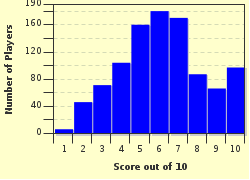Quiz Answer Key and Fun Facts
1. Ralph's first visit was to India. He tells you that whilst treading through scraps of half-eaten fruit and trails of sticky honey, he saw an animal he had never seen before. He tells you that the creature had four inch claws, a dark, shaggy coat, a long snout, and loose lips. Which animal is Ralph describing?
2. After dodging the first unknown beast, Ralph the llama continued on his journey in India. He tells you that although he did not see this next dangerous animal at first, he certainly heard it. He tells you that he followed a strange buzzing sound to find a small, but very aggressive, snake. What type of snake had Ralph found?
3. A bit tired of the scary animals in India, Ralph the llama decided to visit Australia. There are no dangerous animals there, right? Ralph tells you a tale of an almost supernatural sight. After he describes the large ears, thin wings and pale grey fur, you tell Ralph that he actually saw a...what?
4. Ralph the llama begins to get a bit annoyed as he tells you about the time his last jam sandwich was unexpectedly stolen by this next critter. He describes its forked tongue, scaly body, and long muscular tail. He also noted how it was able to scamper up a tree after this outrageous theft. Which Australian creature is Ralph describing?
5. Ralph the llama now tells you about the time he potentially dodged death from another fearful creature in Australia. This animal was much smaller than any he had encountered before. He describes how he noticed the red stripe down its abdomen before hastily brushing it away. A local told him that he had almost been bitten by a "redback". By what other name is this creepy crawly known?
6. Ralph the llama then flew across the Indian Ocean to begin his tour of Africa. He tells you that, instantly after his arrival, he saw a bulky creature poke its head out of the Nile River. As he got closer, the monster mammal opened its enormous jaws to show its huge teeth. What is Ralph describing?
7. Ralph the llama isn't too keen on birds, but this one seems rather tame for now. Its handler told Ralph that it is the national bird of Zambia and Zimbabwe. It had a bright white head and a brown body and wings. Its razor sharp talons and beak make this bird a danger to anyone it sees as a threat! Which bird of prey was Ralph observing?
8. Ralph the llama then tells you that he saw a group of animals in Africa which reminded him of some animals back home in Kent, UK. He describes their big round ears, camouflaged fur and how he noticed their incredible stamina during hunting. Which type of animal did Ralph see on this occasion?
9. Ralph the llama now heads to the coast of Malaysia. As quickly as Ralph jumps in these warm waters, he jumps straight back out. When asked why, he tells you that he saw a long, thin fish, with sharp teeth and a noticeable under bite. The diving instructor told Ralph this fish was probably attracted to his "bling". Which animal did Ralph see?
10. After dodging great bears and poisonous snakes, Ralph the llama is stung by something dangerous in the waters off the coast of Malaysia. Ralph tells you that this dangerous fish was covered in stunning stripes. It uses its venom for defence only, and is smaller in size than most house cats. Which animal has just ended Ralph's journey?
Source: Author
doublemm
This quiz was reviewed by FunTrivia editor
crisw before going online.
Any errors found in FunTrivia content are routinely corrected through our feedback system.

